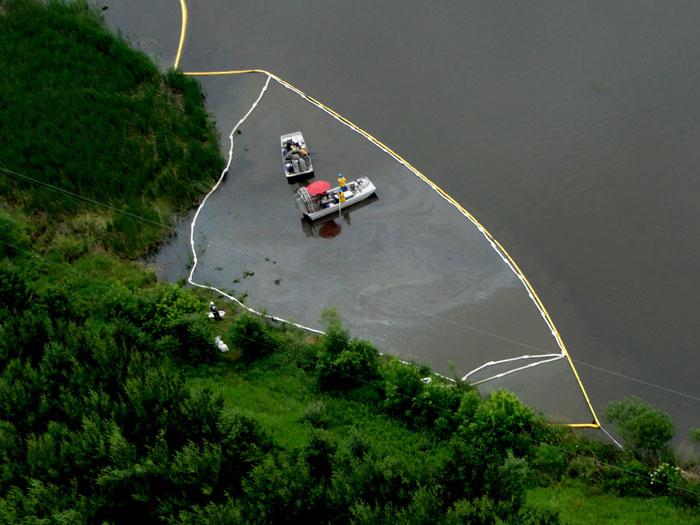Oil Spills Research

Issue
The United States produces, distributes, and consumes large quantities of oil every year. Oil fuels
- our factories,
- power plants,
- homes, and
- transportation.
From the production, storage, transport, and use of oil, 10–25 million gallons of oil spill each year. These oil releases
- threaten public health and safety,
- contaminate drinking water,
- cause fire and explosion,
- diminish air and water quality,
- compromise agriculture,
- destroy recreational areas,
- waste nonrenewable resources,
- cause severe environmental impacts on ecosystems, and
- harm and kill wildlife and plants and destroy habitats and food.
Action
EPA researchers conduct extensive research to mitigate the effects of past and future oil spills. EPA oil spill research includes decades-long monitoring of the impacts of spilled oil. The research includes long-term effects from the 1989 Exxon Valdez incident and technical support in the Deepwater Horizon- BP Gulf of Mexico Oil Spill.
EPA develops laboratory protocols needed for listing commercial products on the National Contingency Plan Product Schedule. Lab, pilot, and field studies provide guidance on the use and implementation of bioremediation on sandy shorelines, wetlands, and salt marshes. Other projects demonstrate which factors are most important for dispersion of oil into the water column at all temperatures.
Oil Spill research includes developing a better understanding of
- fate and effects of spilled oil,
- effective spill response options, and
- testing protocols for spill control.
EPA, in collaboration with Fisheries and Oceans Canada, funded the construction of a wave tank that generates reproducible breaking waves. The wave tank measures the efficiency of dispersants with changing sea turbulence.
EPA is responsible for directing, monitoring, and providing technical assistance for major inland oil spill response activities. This involves
- setting oil prevention and response standards,
- initiating enforcement actions for compliance with the Oil Pollution Act of 1990 (OPA) and Spill Prevention Control and Countermeasure (SPCC) Rule, and
- directing response actions, when appropriate.
EPA researchers continue to be world leaders in improving response actions to oil spills, including all aspects of chemical and biological cleanup.
Results and Impacts
Researchers provide environmental managers and stakeholders the tools, models, and methods they need to understand better the fate and effects of oil spills. EPA studies the impact on ecosystems and different techniques to remediate them more effectively. This work provides responders and communities with essential information on
- the effectiveness of dispersing floating oil;
- how to assess of effects of dispersant treatments on oil contaminating our navigable waters.
EPA researchers provided significant technical support to assist in the Gulf spill emergency. Due to research experience and expertise with spill mitigation and impacts, they quickly responded to frequent questions from Congress and the press. In collaboration with Fisheries and Oceans Canada, EPA used the wave tank at the Bedford Institute of Oceanography (BIO) to answer important questions raised by the Gulf spill on measurement of and monitoring underwater-dispersed oil plumes. Dispersant research continues to expand our understanding of the difference in behavior of oil that has been injected into the deep sea with and without the presence of dispersants.
EPA researchers have produced for the EPA's Office of Emergency Management (OEM) guidelines for the use of commercial bioremediation products and dispersants in mitigating oil spills.
On-going research is studying surface washing agents, solidifiers, and sorbents. EPA is developing a list of commercial products to use in response actions. As a result of EPA oil spill research, commercial products will be listed for use in response actions that will have a greater likelihood of being effective in the field and less toxic to biota.
U.S. EPA. (2012) Science in Action: Determining Which Dispersants Will Be Effective in Future Deepwater Oil Spills. Publication No. EPA/600/F-12/628.
Selected Publications
Rosales, P.I., M.T. Suidan, and A.D. Venosa. (2010). “A Laboratory Study on the Use of Solidifiers as a Response Tool to Remove Crude Oil Slicks on Seawater.” Chemosphere, 80, 4: 389–395.
Venosa, A.D., P. Campo, and M.T. Suidan. (2010). “Biodegradability of Lingering Crude Oil 19 Years After the Exxon Valdez Oil Spill.” Env. Sci. Technol.,44: 7613–7621.
Koran, K.M., A.D. Venosa, C.C. Luedeker, K. Dunnigan, and G.A. Sorial. (2009). “Development and Testing of a New Protocol for Evaluating the Effectiveness of Oil Spill Surface Washing Agents.” Marine Poll. Bulletin, 58: 1903–1908.
U.S. EPA. (2004) "Guidelines for the Bioremediation of Oil-Contaminated Salt Marshes." Publication No. EPA/600/R-04/074.
Venosa, A.D., D.W. King, and G.A. Sorial. (2002). “The Baffled Flask Test for Dispersant Effectiveness: A Round-Robin Evaluation of Reproducibility and Repeatability.” Spill Sci. & Technol. Bulletin, 7, 5-6: 299–308.
U.S. EPA (2001) "Guidelines for the Bioremediation of Marine Shorelines and Freshwater Wetlands." (
Technical Contact
Roger Yeardley, Technology Transfer Specialist
513-569-7548
U.S. EPA National Risk Management Research Laboratory
Land Remediation and Pollution Prevention and Control Division
